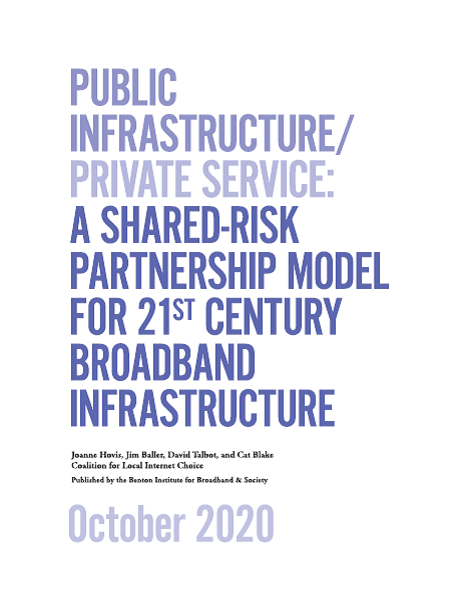Jim Baller

How Can America’s Communities Secure the Benefits of Fiber-Optic Infrastructure?
How can America’s communities secure the benefits of fiber-optic infrastructure? Our answer is that local governments need not accept a binary option of waiting for the private sector to solve the problem—which the private sector already would have done if it made business sense—or taking on the challenge entirely as a public enterprise. Rather, public-private collaboration can disrupt this binary and give communities options.
Arkansas State Legislature Significantly Expands Local Broadband Options
As the Arkansas General Assembly recently found in enacting SB74, “without access to voice, data, broadband, video, and wireless telecommunications services, citizens of Arkansas also lack access to healthcare services, education services, and other essential services; and that this act is immediately necessary to allow government entities to provide high quality voice, data, broadband, video, and wireless telecommunications services to their citizens.” As a result, the Arkansas Senate voted 35-0 and the House voted 94-0 to give government agencies substantial new powers to help accelerate

Public Infrastructure/Private Service Model For 21st Century Broadband Proves Worthy
The emerging model presents a scalable option for communities that lack the expertise or interest to operate networks or act as ISPs themselves but want to own and control the core communications assets in their communities as a means of securing the benefits of broadband internet. Here’s a look at the model’s business case, technical elements and risks.
Legal Issues in Broadband Public-Private Partnerships: Finding a Private Partner
A growing number of local governments are coming to see fiber broadband networks as essential infrastructure for the 21st century, infrastructure that is capable of driving and supporting simultaneous progress in just about every area of significance to their communities. This includes economic development, education, health care, environmental protection, energy, transportation, government services, digital equity, and much more.
Public Infrastructure/Private Service: A Shared-Risk Partnership Model for 21st Century Broadband Infrastructure
The Public Infrastructure/Private Service model puts the locality in the business of building infrastructure, a business cities and counties know well after a century of building roads, bridges, and utilities. The model leaves to the private sector most aspects of network operations, equipment provisioning, and service delivery. The Public Infrastructure/Private Service model leverages the best capabilities of the public and private sectors.
Private-sector investment alone is not closing our digital gaps. The Public Infrastructure/Private Service model offers a promising solution that is precisely targeted to the areas with greatest broadband gaps, frequently those with lower income levels and lower population densities.

Analysis of the FCC’s Third Report and Order and Declaratory Ruling on Pole Attachments and Wireless Siting, One-Touch Make-Ready
On August 2, 2018, the Federal Communications Commission adopted a Third Report and Order (Third R&O) and Declaratory Ruling in its on-going wireline and wireless infrastructure proceedings aimed at removing barriers to broadband deployment. In the Third R&O the FCC significantly revised its rules and regulations governing the pole attachment “make-ready” process, including the establishment of a one-touch make-ready (OTMR) process.
Announcing the Coalition For Local Internet Choice
We are proud to announce the Coalition for Local Internet Choice. We are a diverse coalition of public and private entities who seek to protect the rights of local communities to determine their economic futures by having the right and opportunity to choose for themselves the best broadband internet infrastructure for their businesses, institutions and residents.
Why Local Internet Choice? Modern Internet infrastructure is foundational to the economic futures of our communities -- as well as the democratic discourse that thrives on the Internet. And meeting the challenge of enabling that infrastructure will require the engagement of all parties, both private and public.

